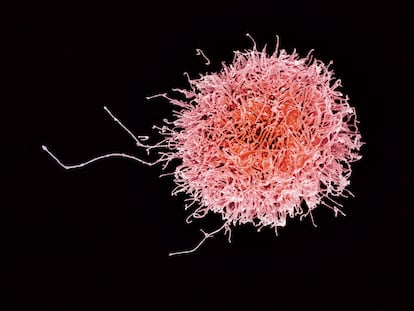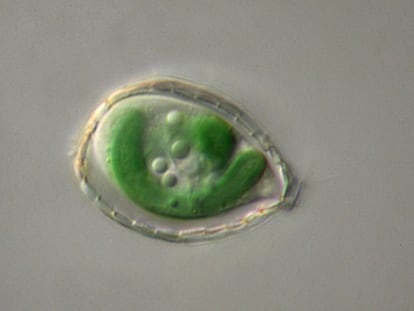Robert Schreiber: ‘I think we are on the verge of seeing cancer as a chronic disease’
The US researcher, who recently accepted an honorary degree in Barcelona, defends the use of immunotherapy, either alone or in combination with other treatments, to combat tumors

This is a good time to be an immunologist, says Robert Schreiber, 76, a leading researcher in the interaction between the immune system and cancer who teaches at the Washington University School of Medicine. “It is an exciting time: we are in the golden age of immunology and for immunotherapy against cancer,” he says with a smile from the imposing Ramón y Cajal lecture hall of the University of Barcelona, where he is about to be awarded an honorary degree for his scientific contribution to the demonstration that the immune system can be a therapeutic tool against cancer.
These are good times for immunology research, but it wasn’t always that way. “When young people say to me, ‘But wasn’t this [that the immune system can help fight cancer] already known?’ I say, ‘Let me tell you a story...,’” Schreiber laughs.
It was not easy putting the immune system at the center of the fight against cancer. Its potential role in combating tumors was an old idea dating back to the beginning of the 20th century that did not quite take hold; and it remained there, as a mere hypothesis, in the minds of a few researchers who “didn’t have the experimental momentum to really be able to nail what was going on,” admits Schreiber. But years later, he and his team took up the idea again, which, based on small findings, culminated in the demonstration, in the early 2000s, of the rules of the game between the immune system and cancer: Schreiber postulated the theory of cancer immunoediting, the paradox that, although the immune system protects against tumor cells, it can also promote their development.
Their findings helped open the door to immunotherapy against tumors, the great therapeutic revolution of the last decade.
Question. If the immune system can protect against cancer, but can also favor its development, is it our ally or our enemy?
Answer. We’re still trying to figure that out, actually. It’s a process, and the first part of the process is if the immune system recognizes a tumor that’s formed because there are abnormal proteins in the tumor, and every tumor has abnormal proteins, then there’s a potential for the immune system to destroy those cells, leaving the normal cells behind. We call that elimination, and that’s the first step in this process. But then what happens is if the tumor is heterogeneous, and many tumors are, then there are cells that don’t express that same mutation and the immune system doesn’t recognize it. And so by clearing out the ones that can be easily recognized, the immune system basically now makes a troop of really bad tumor cells, and they now grow.
Q. New cancer treatments emerge, they work, but then tumors always emerge that generate resistance. It is like an eternal race between cat and mouse.
A. That’s why very few of us will ever use the word cure when we’re talking about immune responses to cancer or cure with respect to any response to cancer. And so it is a cat and mouse game, and it starts naturally just as cancers arise: the immune system that we all have, and it’s very personalized to each of us, can see some of those cells and get rid of them. What’s left over if they now start to grow? What happens if you use immunotherapy instead of just using the natural immune response? There are big drugs now that are showing remarkable effects on maybe 20% of the patients. If it’s melanoma, it’s 80% of the patients, but many of these cancers are only 20% responsive. So now you come in with another treatment, maybe even radiation. Radiation can make new mutations in a tumor and give the immune system another opportunity to kill. So they get rid of those. But now you have other ones coming up. And so we don’t know if this is going to be years and years and years of treatment with different combinations of therapies. Many feel that what is attainable for us now is to make cancer a chronic disease like diabetes.
Q. What happens in tumors such as breast or pancreatic cancer, where immunotherapy does not work, and what differentiates these neoplasms from lung cancer or melanoma, where it does work better?
A. We’re trying to figure this question out. Some people felt that it was simply the number of mutations that a particular cancer has. And so melanoma, because it’s caused by UV light, gives many mutations. And so you’ll often see melanomas with 1000 mutations, pancreatic cancer is much lower. It’s about 24 to 30 mutations. But we consider that these tumors are little universes in themselves and they not only contain the tumor cells, but they contain many other cells. And one of the things about pancreatic cancer is they have a very high level of myeloid cells in them and they make a desmoplastic. They’re like little rocks and so the T cells that would be doing the effector function and killing off the pancreatic cancer have a very difficult time getting into there. And once they get in there, they meet up with these immunosuppressive myeloid cells, and that makes them even worse.
Q. Will immunotherapy eventually take the place of other treatments, such as chemotherapy or radiotherapy?
A. Chemotherapy, radiation therapy, things like that work very differently than immunotherapy, although there’s a feeling that even in those kinds of nonimmunologic therapies, there’s an immune component. So you treat with radiation, you make new antigens. The immune system now sees those and they can facilitate destruction. We think that ultimately having the ability of making different combinations is going to be necessary and we need the guidelines to figure out what the criteria are to use radiation therapy plus immunotherapy or just immunotherapy alone, and so on.

Q. What more needs to be discovered about the immune system?
A. Compared to where we were 20 years ago, we know so much more now than we did then. We still need to learn many things about how the immune system works and how we can target certain things in the immune system to either get them to work better or to block something that is inhibiting. The big question right now is this idea of having strong, focused research in immune tumor interactions and ultimately immunotherapy and then translating those findings that we often get from experimental animals and then into humans and seeing how they work and how do we logically pick the kinds of therapy that we would treat a patient with. We’re in a revolution. We have now several things that are working somewhat. But we need to figure out how to make them work consistently in all patients.
Q. How is cancer vaccine research doing?
A. We were one of the first laboratories to show that if you sequence a tumor and you identify the mutations and you predict which of those mutations are good antigens for T cells, that you could make a vaccine and vaccinate a tumor-bearing animal and have them reject their tumor. And that has been taken into the clinic. And there are several groups now all over the world that are trying to do this. But we showed this with vaccines that were made with peptides that included the mutation that we were targeting. There were ten to 20 in the patient. The problem was that these were highly personalized vaccines. So the only person in the world that would benefit from this vaccine was that one person that we sequenced.
Big Pharma hates this idea because they don’t like personalized. They want off the shelf. So one argument that gets around us a little bit is, as we’re now many groups doing more and more sequencing, what we’re finding is that suddenly we’re coming up with mutations that are seen in more than one patient. Steve Rosenberg’s group, for example, has found that the KRAS gene, which is in 20% of human tumors, mutated, can be an antigen that could be used in a vaccine for many people. I think the only kind of vaccine that drug companies will be most excited about will be the vaccines that target common mutations in tumors.
Q. Realistically, will we see cancer disappear or rather see it become a chronic disease?
A. I think we are on the verge of seeing cancer as a chronic disease, although we lump everything into one big term of cancer, and there are so many differences...But I would say certainly for some kinds of cancer, we’re getting closer to making it a chronic disease. Every once in a while, you see these patients whose cancers never return. And it’s fantastic. But whether or not that is going to be the I think we have much more to learn before we can actually say we can cure it.
Tu suscripción se está usando en otro dispositivo
¿Quieres añadir otro usuario a tu suscripción?
Si continúas leyendo en este dispositivo, no se podrá leer en el otro.
FlechaTu suscripción se está usando en otro dispositivo y solo puedes acceder a EL PAÍS desde un dispositivo a la vez.
Si quieres compartir tu cuenta, cambia tu suscripción a la modalidad Premium, así podrás añadir otro usuario. Cada uno accederá con su propia cuenta de email, lo que os permitirá personalizar vuestra experiencia en EL PAÍS.
¿Tienes una suscripción de empresa? Accede aquí para contratar más cuentas.
En el caso de no saber quién está usando tu cuenta, te recomendamos cambiar tu contraseña aquí.
Si decides continuar compartiendo tu cuenta, este mensaje se mostrará en tu dispositivo y en el de la otra persona que está usando tu cuenta de forma indefinida, afectando a tu experiencia de lectura. Puedes consultar aquí los términos y condiciones de la suscripción digital.
More information
Últimas noticias
There is as much life left to discover on planet Earth as that which is already known
Dozens presumed dead, around 100 injured in fire at Swiss Alps bar during New Year’s celebration
Is porn for women different from conventional porn? We spoke to those who make it
Cartagena de Indias is sinking: What can the city do to mitigate it?
Most viewed
- Reinhard Genzel, Nobel laureate in physics: ‘One-minute videos will never give you the truth’
- David King, chemist: ‘There are scientists studying how to cool the planet; nobody should stop these experiments from happening’
- Sinaloa Cartel war is taking its toll on Los Chapitos
- Oona Chaplin: ‘I told James Cameron that I was living in a treehouse and starting a permaculture project with a friend’
- The Interoceanic Train, the Mexican alternative to the Panama Canal











































